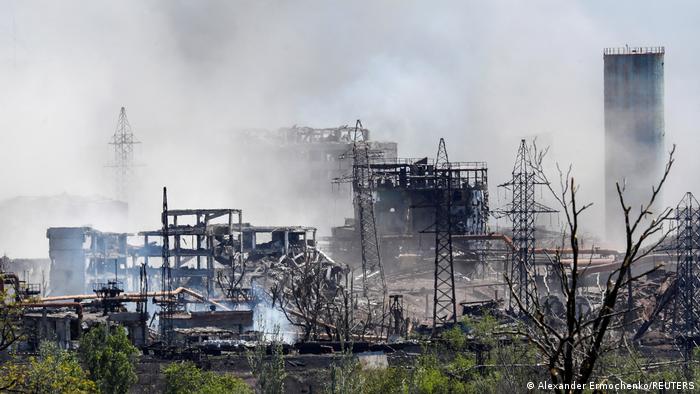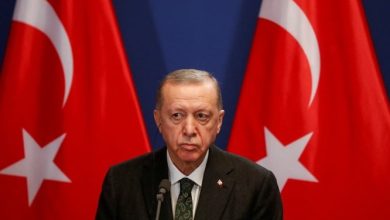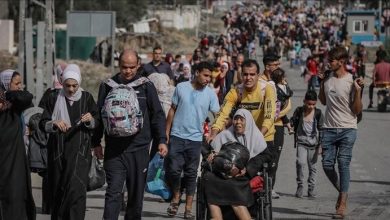Russia claims ‘full control’ of Mariupol steel plant

Russia’s claimed seizure of a Mariupol steel plant that became a symbol of Ukrainian tenacity gives Russian President Vladimir Putin a sorely needed victory in the war he began, capping a nearly three-month siege that left the city in ruins and more than 20,000 residents feared dead.
After the Russian Defense Ministry announced late Friday that its forces had removed the last Ukrainian fighters from the plant’s miles of underground tunnels, concern mounted for the Ukrainian defenders who now are prisoners in Russian hands.
“I believe that a tribunal is inevitable here. I believe that justice must be restored. There is a request for this from ordinary people, society, and, probably, the sane part of the world community,” Russian state news agency Tass quoted Pushilin as saying.
Russian officials and state media repeatedly have tried to characterise the fighters who holed up in the Azovstal steel plant as neo-Nazis. Among the plant’s more than 2,400 defenders were members of the Azov Regiment, a national guard unit with roots in the far right.
The Ukrainian government has not commented on Russia’s claim of capturing Azovstal, which for weeks remained Mariupol’s last holdout of Ukrainian resistance, and with it completing Moscow’s long-sought goal of controlling the city, home to a strategic seaport.
Ukraine’s military this week told the fighters holed up in the plant, hundreds of them wounded, that their mission was complete and they could come out. It described their extraction as an evacuation, not a mass surrender.
The impact of Russia’s declared victory on the broader war in Ukraine remained unclear. Many Russian troops already had been redeployed from Mariupol to elsewhere in the conflict, which began with the Russian invasion of its neighbour on February 24.
Russian Defense Ministry spokesman Igor Konashenkov reported on Saturday that Russia had destroyed a Ukrainian special-operations base in Black Sea region of Odesa as well as significant cache of Western-supplied weapons in northern Ukraine’s Zhytomyr region. There was no confirmation from the Ukrainian side.
In its morning operational report, the Ukrainian military general staff reported heavy fighting in much of eastern Ukraine, including the areas of Sievierodonetsk, Bakhmut and Avdiivka.
Since failing to reach and capture Ukraine’s capital, Kyiv, Russia focused its offensive in the country’s eastern industrial heartland. The Russia-backed separatists have controlled parts of the Donbas region since 2014, and Moscow wants to expand the territory under its control.
Mariupol, which is part of the Donbas, was blockkaded early in the war and became a frightening example to people elsewhere in the country of the hunger, terror and death they might face if the Russians surrounded their communities.
As the end drew near at the steel plant, wives of fighters who had held out told of what they feared would be their last contact with their husbands.
Olga Boiko, the wife of a marine, wiped away tears as she shared the words her husband wrote her on Thursday: “Hello. We surrender, I don’t know when I will get in touch with you and if I will at all. Love you. Kiss you. Bye.” The wife of another fighter, Natalia Zaritskaya, said her husband reported earlier this week that of the 32 soldiers with whom he had served, only eight survived and most were seriously wounded.
“Now they are on the path from hell to hell. Every inch of this path is deadly,” Zaritskaya said.
The seasize steelworks, occupying some 11 square kilometers (4 square miles), had been a battleground for weeks. The dwindling group of outgunned fighters held out with the help of air drops of supplies, drawing Russian airstrikes, artillery and tank fire, before their government ordered them to abandon the plant and save themselves.
Russia said the Azov Regiment’s commander was taken away from the plant in an armored vehicle because of local residents’ alleged hatred for him. No evidence of Ukrainian antipathy toward the nationalist regiment has emerged. The Kremlin has seized on the regiment’s far-right origins in its drive to to cast the invasion as a battle against Nazi influence in Ukraine.
Russian authorities have threatened to investigate some of the steel mill’s defenders for war crimes and put them on trial. Capturing Mariupol furthers Russia’s quest to essentially create a land bridge from Russia via much of the Donbas area bordering Russia to the Crimean Peninsula, which Moscow annexed from Ukraine in 2014.
The city’s seizure also helps Russian leader Putin offset some stinging setbacks, including the failure to take over Kyiv, the sinking of the Russian Navy’s flagship in the Black Sea and continued resistance that has stalled the offensive in eastern Ukraine.
With Mariupol under Russian control, Ukrainian authorities are likely to face delays in documenting evidence of alleged Russian atrocities in the city, including the bombings of a maternity hospital and a theater where civilians had taken cover.
Satellite images in April showed what appeared to be mass graves just outside Mariupol, where local officials accused Russia of concealing the slaughter by burying up to 9,000 civilians.
Earlier this month, hundreds of civilians were evacuated from the plant during humanitarian cease-fires and spoke of the terror of ceaseless bombardment, the dank conditions underground and the fear that they wouldn’t make it out alive.
At one point in the siege, Pope Francis lamented that Mariupol had become a “city of martyrs.” An estimated 100,000 of the 450,000 people who resided there before the war remain. Many, trapped by Russia’s siege, were left without food, water and electricity.
Earlier this month, hundreds of civilians were evacuated from the steel plant during humanitarian cease-fires. They spoke of the terror of ceaseless bombardment, the dank conditions underground and the fear that they wouldn’t make it out alive.
The chief executive of Metinvest, a multinational company which owns the Azovstal plant and another steel mill, Ilyich, in Mariupol, spoke of the city’s devastation in an interview published Saturday in Italian newspaper Corriere della Sera.
“The Russians are trying to clean it (the city) up to hide their crimes,” the newspaper quoted Metinvest CEO Yuriy Ryzhenkov as saying. “The inhabitants are trying to make the city function, to make water supplies work again.” “But the sewer system is damaged, there has been flooding, and infections are feared” from drinking the water, he said.
The Ilyich steelworks still has some intact infrastructure, but if the Russians try to get it running, Ukrainians will refuse to return to their jobs there, Ryzhenkov said.
“We will never work under Russian occupation,” Ryzhenkov said.





